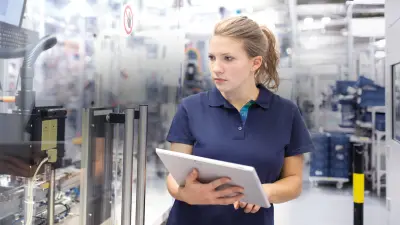Connectivity for the products of the future
Bosch Research researches and develops futuristic connectivity technologies.

It is hard to imagine industry and day-to-day life without connectivity technologies. Whether it be the automation of mobility and production, connected products and the software-defined manufacturing of tomorrow or virtual realities — numerous industries are facing a major upheaval. They all have one thing in common: they depend on large amounts of data being exchanged quickly, securely and in a targeted manner – in most cases wirelessly.
High-performance, reliable networks are the basis for all these applications. To ensure smooth processes, speed, reliability and real-time capability must be guaranteed at all times. To this end, we at Bosch Research are researching innovative connectivity technologies and working on connectivity standards.
From 5G to 6G: Bosch Research is driving wireless communication
The new 6G mobile standard will be introduced in 2030. It will allow ever larger quantities of data to be processes with reduced latency: 400 gigabits per second (Gbit/s) will then be possible and the latency will be in the range of microseconds. 6G has great significance, especially with regard to automated driving. After all, the standard will allow additional features not provided by the established 5G system which go beyond communication, for example detection of the environment as is possible with a radar sensor. With the 5G network, it is already possible to determine the position of connected vehicles or road users. Through sensing with a 6G antenna, it will be possible to detect passive objects as with a radar system.
Until that time comes, the fifth generation of mobile communications — 5G — will remain in use. This already makes it possible to transmit data volumes at speeds of up to 20 Gbit/s — a transmission rate 200 times higher than with 4G (LTE), with near real-time behavior at the same time. While 4G and its predecessor 3G made mobile Internet available to consumers for the first time, 5G's inherent characteristics will allow it to be used in other industries as well. These include the automotive sector, industrial production (Industry 4.0) and agriculture.
Latency: Milliseconds make all the difference
The latency of data transmission and the reliability of the connection are among the greatest challenges when researching connectivity technologies. Latency in the mid-millisecond range goes unnoticed by humans using the mobile Internet, but in industrial applications without human involvement this minimal delay can be an obstacle or even lead to failures.
For industrial applications and connected driver assistance systems, the demands on 5G are particularly high. Connections classified as ultra reliable low latency communications (uRLLC) which offer a latency of less than half a millisecond are needed here. In terms of reliability, the values expected of wired connections should be achieved.
Connected applications at Bosch Research
Together with Bosch’s Building Technologies (BT) division, Bosch Research is also researching building technologies. Its range of products includes wireless conference systems. These systems connect many devices at the same time via WiFi and are therefore susceptible to the interference encountered in home networks. To achieve the required level of reliability in the connection, Bosch Research is working on so-called “predictive quality of service” with the help of algorithms and artificial intelligence (AI). This describes the ability of a system to predictively guarantee data rate, latency and connection quality. Faults should be detected by the system as soon as they occur or even beforehand, so that connection problems can be rectified before noticeable interruptions occur. The system thus receives a signal from the AI with a lead time of 100 milliseconds that there is a problem and that it will need to change the channel for example. This all takes place automatically and unnoticed by conference participants.
In contrast, the development of connectivity technologies for connected vehicles (Vehicle to X, V2X) focuses on traffic safety and traffic efficiency. Here, Bosch Research is working on using V2X messages to warn car drivers and e-bike riders of possible collisions. Our research topics also include supporting automated driving using V2X or allowing high levels of automation in the first place. To make this possible, Bosch has developed communication mechanisms which define how vehicles communicate with each other. In an example scenario, a vehicle informs other vehicles of possible routes it might take. The other vehicles receive this message and react by transmitting their own planned trajectories. In this ideal scenario, the vehicles negotiate together what the coordinated maneuver should be and adjust their trajectories accordingly.
Vehicle connectivity also allows us to implement so-called teleoperated driving. In this case, a vehicle is remote controlled from a control center. One of many deployment scenarios is an autonomous vehicle that stops at a construction site because it is not cleared to drive there. A person at the remote control center is then connected, sees the video image from the vehicle camera(s), and can remotely drive the vehicle at low speed. Highly reliable communication with low latency is essential in this case. Predictive quality of service is used here as it is in a conference room. Algorithms detect connection quality problems early on and can reduce the data rate to ensure stable transmission, albeit with a lower image quality. Information security too is an important issue in this case: If the system were attacked by hackers and the control system were taken over by a third party, this could pose significant risks. And operational safety is also a critical factor because people could be harmed if control is not guaranteed, for example owing to a poor connection.
Focus on information security
Wireless networks are much more vulnerable to attacks from outside than wired networks. Encryption technologies thus play a major role in securing data traffic against cyber attacks and protecting user data.

